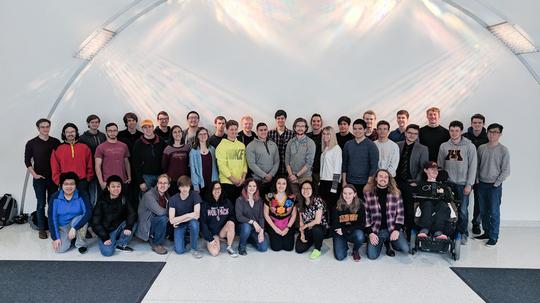
A group of undergraduate students from the University of Minnesota's College of Science and Engineering shot for not quite the moon but the International Space Station recently, when the school's first small satellite was sent into orbit.
The satellite, which deployed into Earth's orbit Feb. 19 at 8:30 a.m., is called SOCRATES (Signal Opportunity CubeSat Ranging and Timing Experiment System). It was created by the university's Small Satellite Research Group, an interdisciplinary team building small satellites sponsored by NASA and the U.S. Air Force Office of Scientific Research.
SOCRATES is the first small satellite built by the Unversity of Minnesota Twin Cities to go into space.
The students' work may be over, but SOCRATES' mission has just begun. Pitched to NASA in 2016, SOCRATES has two missions. The first, the school says, involves using pulsars to facilitate x-ray-based navigation, a means of positioning oneself in space when GPS is not available. The satellite's second job will be investigating electronic accelerations in solar flares in order to understand the science behind solar anomalies.
Now that SOCRATES is in orbit, the Minnesota team will try to make contact from ground stations across the country, including one in northern Minnesota. It hopes to gather at least six months of continuous data from the CubeSat.
The project was established by aerospace engineering and mechanics professor Demoz Gebre-Egziabher and physics professor Lindsay Glesener. Its student project leaders are Jenna Burgett, the project manager, and Kyle Houser, chief engineer.
"We're trying to provide an undergraduate experience on real engineering and physics-based projects," Houser said in a statement. "The biggest impact this has on our future careers is that you set yourself apart by just being on the project and seeing how these things operate."
More than 30 students with a variety of majors were involved in the project. Most are aerospace engineering and physics majors, but the team also includes specialties like electrical engineering and math.
SOCRATES flew to the International Space Station with NASA's Cygnus NG-12 mission on Nov. 2 before launching into Earth's orbit last week.
The team is now working on two other small satellites: EXACT (Experiment for X-ray Characterization and Timing) and IMPRESS (Impulsive Phase Rapid Energetic Solar and Timing). They are expected to launch in 2021 and 2022 respectively, Minnesota Daily reports.








